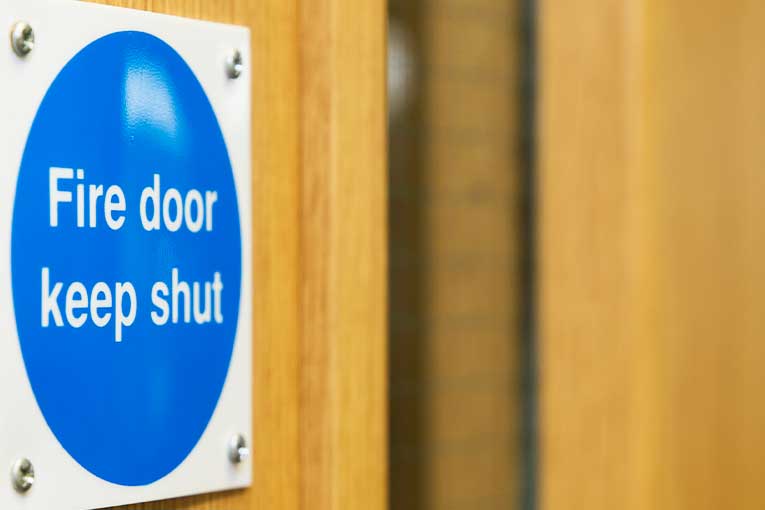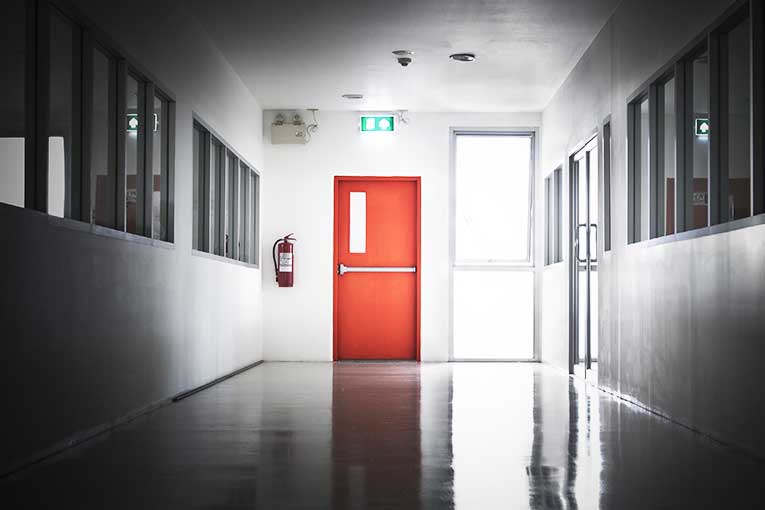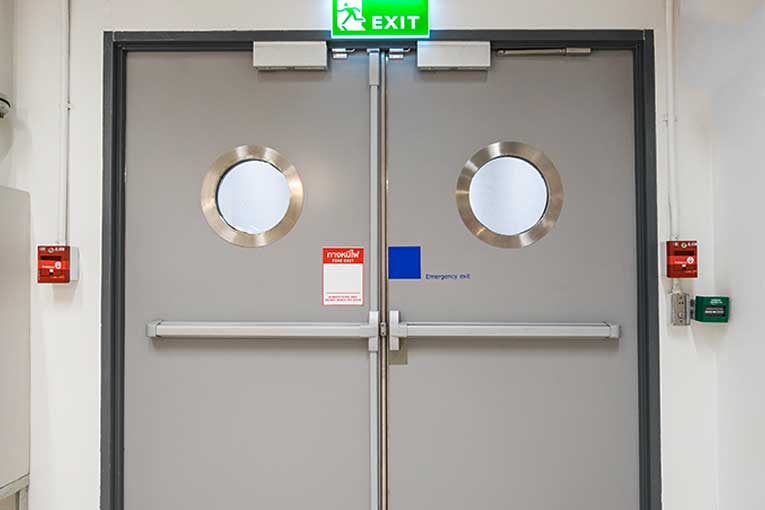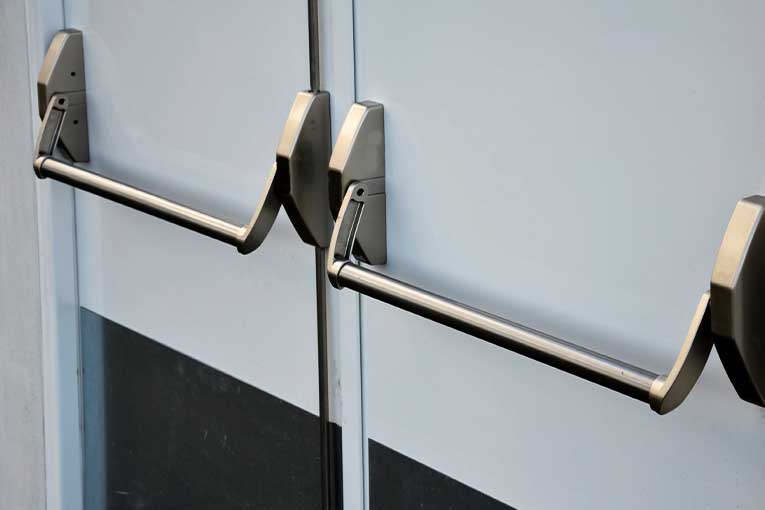Where are Fire Doors Required & Why Are They Needed?
- October 1, 2023
- 8:00 am


Simon Burge
Share this content
One of the most common questions with regards to fire safety is where are fire doors required?
Fire safety is of paramount importance in any building or structure, and fire doors are an integral part of ensuring the safety and protection of occupants and property during a fire emergency.
These specialised doors are meticulously engineered to serve as barriers against the rapid spread of fire, smoke, and toxic gases, effectively compartmentalising the building and providing valuable time for evacuation and firefighting efforts.
In this article we will answer questions such as where are fire doors required, why fire doors are needed, what materials are used in their construction, what regulations that govern their installation, what safety checks are needed to maintain their functionality and what their cost implications are.
Where are Fire Doors Required?
Where fire doors are required is one of the most common questions raised by new business owners.
They are required by law in all properties that are for business or non-domestic usage.

Fire doors play an essential role in various settings to enhance fire safety and protect occupants from the dangers of fire incidents.
They are strategically installed in a wide range of locations, including commercial buildings, residential buildings, industrial facilities, educational institutions, and healthcare facilities.
Commercial Buildings
Fire doors serve a critical role in securing escape routes during a fire emergency, providing occupants with a clear and safe path to evacuate the building.
In various commercial settings, such as offices, hotels, restaurants, and shops, fire doors are essential for ensuring the safety of employees, customers, and visitors.
These doors compartmentalise the building, containing the fire and allowing occupants to safely exit.
Similarly, in multi-occupancy residential buildings like apartments and care homes, fire doors play a crucial role in safeguarding residents.
By preventing the rapid spread of fire between units, fire doors provide precious time for evacuation and help minimise the impact of the fire on the entire building.
Industrial Facilities
Industrial facilities, including manufacturing plants, warehouses, and storage areas, require fire doors to protect both employees and valuable assets.
In these settings, the risk of fire can be significant due to the presence of flammable materials and machinery.
Fire doors play a crucial role in such environments by sectioning the building.
In the event of a fire, the fire doors act as barriers, containing the fire to a specific area and preventing its rapid spread.
This containment allows employees to safely evacuate the affected area and seek refuge in other fire-resistant compartments until help arrives.
By containing the fire, fire doors help to minimise damage to the facility, its contents, and the surrounding areas.
They also provide additional time for emergency responders to arrive and mitigate the situation.
This is vital in industrial settings where a rapid and uncontrolled fire could have catastrophic consequences for both human lives and business operations.
Educational Institutions
Fire safety is a top priority in educational institutions like schools, colleges, and universities, where the safety and well-being of students, staff, and visitors are of utmost importance.
To achieve this, fire doors are strategically installed throughout the buildings.
In educational settings, fire doors are commonly found in corridors, classrooms, and assembly areas.
Healthcare Facilities
Healthcare facilities, including hospitals and clinics, must maintain a safe environment to protect patients and staff.
Fire doors are a critical component of fire safety in healthcare settings, ensuring that patients can be evacuated safely and that critical areas, such as operating rooms and patient wards, remain protected.
Where are Fire Doors Required in a House?
In most residential properties, fire doors are not required by law, however there are exceptions to this rule.
If the property is 3 stories or more, for example a block of flats, then a fire door is needed on every floor where a room connects onto the stairwell.
Also, if a garage connects directly to a property with access via a door, then the door must comply with fire safety regulations.
Some property owners install fire doors where not required by law, just to increase fire safety in the property.
If fire doors are installed in a house, then they are strategically placed in key areas to prevent fire spread:
- Kitchen: Fire doors in the kitchen separate it from living spaces, containing potential fires.
- Garage: Fire doors are crucial if the garage has direct access to living areas.
- Basement: Fire doors may be necessary in the basement to protect escape routes and contain fires.
What Do Fire Doors Do?
Fire doors serve as essential components of passive fire protection measures, providing critical barriers to contain flames, smoke, and toxic gases in the event of a fire.
When a fire occurs, the proper functioning of fire doors can significantly impact the safety of building occupants and the overall integrity of the structure.

One of the primary functions of fire doors is their ability to compartmentalise a building.
When closed, fire doors form a seal between different areas of the building, preventing the rapid spread of fire and smoke to other parts of the structure.
By containing the fire to its point of origin, fire doors effectively limit the extent of damage and provide occupants with valuable time to evacuate the building safely.
What are Fire Doors Made From?
Fire doors are made from various materials with excellent fire-resistant properties, ensuring that they can withstand high temperatures and intense heat.
Timber
Timber is a commonly used material for fire doors, valued for its aesthetic appeal and reliable fire protection.
Solid timber fire doors offer a classic and natural look, making them a popular choice for residential and commercial buildings alike.
Timber fire doors are available in various finishes and can be customised to complement the overall interior design of a space.
The thickness and quality of the timber used in the door’s construction determine its fire-resistant capabilities.
Steel
Steel fire doors are another widely used type of fire door, particularly in commercial and industrial settings.
Steel doors offer exceptional strength and durability, making them suitable for high-traffic areas and locations with more stringent security requirements.

Steel fire doors can be coated with fire-resistant materials to enhance their fire resistance, and they are often used in facilities where protection against fire and potential break-ins is paramount.
Composite
Composite fire doors are a versatile option that combines various materials to provide enhanced fire resistance and durability.
These doors typically feature a core made from fire-resistant materials, such as mineral wool or vermiculite boards, sandwiched between layers of other materials like timber, steel, or laminate.
The combination of different materials in composite fire doors creates a door that is both robust and capable of withstanding the effects of fire for an extended period.
What are the Regulations of Fire Doors?
Fire doors play a crucial role in fire safety, and to ensure their effectiveness, they must adhere to specific regulations and standards.
These standards are designed to test and assess the fire resistance and integrity of fire doors, ensuring that they can withstand the impact of a fire and provide adequate protection to occupants and property.
Fire Rating
One of the essential aspects of fire door regulations is the fire rating.
Fire doors are rated based on their ability to withstand fire for a specific duration, usually indicated as 30, 60, or 90 minutes.
This fire rating determines how long the door can effectively contain the spread of fire, smoke, and heat, providing occupants with valuable time to evacuate safely and emergency responders to take action.
Integrity
In addition to fire resistance, fire doors must also maintain their structural integrity during a fire.
This means that they should prevent the passage of flames and smoke, forming a barrier that can effectively contain the fire to a specific area of the building.
The ability of fire doors to maintain their integrity is critical in preventing the rapid spread of fire, protecting other parts of the building and allowing a more controlled response to the emergency.
Self-Closing Mechanism
Another essential feature of fire doors is the self-closing mechanism.
Fire doors should automatically close and latch when not in use, ensuring that they are ready to act as a barrier in case of a fire.
This self-closing mechanism helps prevent the accidental propping open of fire doors, which could compromise their effectiveness during an emergency.
Labelling
To provide clear and easily accessible information, fire doors should have appropriate labelling.
The label on a fire door typically indicates its fire rating and compliance with safety standards.
This labelling helps building occupants and emergency responders quickly identify fire doors and understand their fire resistance capabilities.
How are Safety Checks on Fire Doors Carried Out?
A proper safety check on fire doors is essential to ensure their functionality during an emergency, and has to be done by someone trained in fire door inspections.
Here are some key steps to include in a fire door safety inspection:
Check Closers
Verify that the door closes smoothly and latches securely without any obstructions.
Proper functioning closers are crucial to ensure that the door can effectively close and seal off the area in case of a fire.
Inspect Seals
Ensure that intumescent seals around the door frame and perimeter are intact.
These seals expand when exposed to heat, creating a barrier against the spread of flames and smoke.
Examine Hinges
Check for loose or damaged hinges that could affect the door’s performance.
Hinges should be in good condition and securely attached to the door and frame.
Look for Damage
Check for any cracks, holes, or damage that may compromise the door’s integrity.
Any damage to the door can weaken its ability to withstand fire and limit its effectiveness in containing flames and smoke.
Test Latching
Confirm that the latch engages correctly with the strike plate when the door is closed.
A properly functioning latch ensures that the door remains closed and prevents the passage of smoke and flames.
Evaluate Gap Sizes
Ensure that the gaps around the door are within the specified limits.
Properly sized gaps are essential for the door’s fire resistance, as excessive gaps can allow the passage of smoke and flames.
Regular fire door inspections are critical to maintaining their effectiveness in fire safety.
If any issues are identified during the safety check, prompt repairs or replacements should be made to ensure that the fire doors are ready to perform their vital role in protecting lives and property during a fire emergency.
Changes in Regulations
As of January 2023, there have been significant changes to the fire door inspection regulations, due to the majority of fire doors in the UK failing inspections.
Previously, inspections were conducted every six months to ensure compliance with fire door rules and regulations.
However, with the new regulations in place, there are updated inspection frequencies for different types of fire doors:
Communal Fire Doors
These will now be expected to undergo inspection every 3 months.
This increased frequency aims to enhance safety and ensure that communal areas are adequately protected.
Fire & Escape Doors (FEDs)
FEDs will be subject to inspection at least once a year.
This measure aims to maintain the integrity of escape routes and vital access points in buildings.

These changes reflect a more proactive approach to fire safety, ensuring that fire doors are regularly checked and maintained to meet the highest safety standards.
Can Fire Doors Have Windows?
Fire doors are designed with the option of including vision panels that are equipped with fire-resistant glazing.
These vision panels offer the advantage of visibility between different areas, allowing natural light to pass through while maintaining fire safety regulations.
High-quality fire-rated glass can withstand temperatures of up to 900 degrees Celsius, over seven times that of normal glass.
Moreover, it can maintain its integrity for over 60 minutes, effectively preventing the fire from spreading and providing ample time for evacuation and fire personnel to respond.
By following these regulations, property owners can strike a balance between safety and functionality, providing occupants with both fire protection and the convenience of visual communication within the building.
How Much Do Fire Doors Cost?
The cost of fire doors can vary significantly depending on several factors.
The primary determinants of the price include the material used, the fire rating of the door, its size, and any additional features it may have.
Here are some key factors that influence the cost of fire doors:
Material
Fire doors can be made from various materials, including timber, steel, and composite materials.
Each material has different characteristics and price points, with steel doors generally being more expensive than timber doors.
Fire Rating
Fire doors are assigned specific fire ratings, indicating the duration they can withstand exposure to fire.
Doors with higher fire ratings tend to be more expensive due to their increased fire resistance capabilities.
Size
The size of the fire door is another important factor in determining its cost.
Larger doors may require more materials and hardware, resulting in a higher price.
Additional Features
Some fire doors come with additional features, such as vision panels, glazing, or special hardware.
These features can add to the overall cost of the door.
The cost of a standard fire door can vary because of these factors, with a low-end fire door being rather low cost, to the upper end coming in with a price tag in the thousands.
However, it is essential to consider that investing in high-quality fire doors is a crucial aspect of ensuring fire safety in any building.
Fire doors play a critical role in preventing the spread of fire and protecting lives and property.
Therefore, it is recommended to prioritise the quality and compliance of fire doors over cost considerations to ensure the utmost safety and security in the event of a fire emergency.
Conclusion
Fire doors are indispensable components of fire safety measures, protecting lives and properties during emergencies.
Having an answer to the question of where are fire doors required, as well as their functions, materials, regulations, and safety checks is essential for creating a secure environment.
Whether in commercial buildings, residential properties, or industrial facilities, the proper installation and maintenance of fire doors contribute significantly to fire prevention and enhanced safety for occupants.



